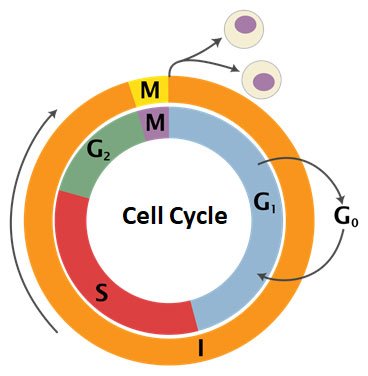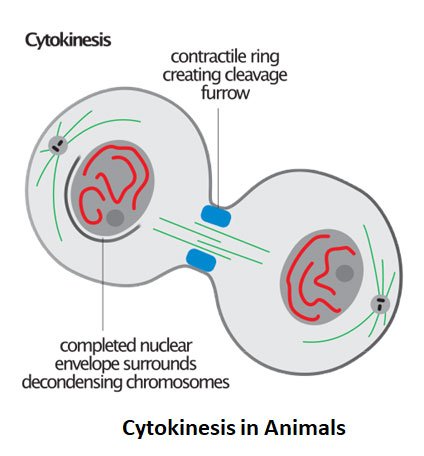Cell division is an essential process by which cells replicate to ensure growth, development, tissue repair, and reproduction in living organisms. The two primary types of cell division are mitosis and meiosis. Mitosis leads to the formation of two genetically identical daughter cells, while meiosis results in four genetically distinct gametes with half the chromosome number of the parent cell. Cell division is tightly regulated by several checkpoints, proteins, and enzymes to prevent errors such as uncontrolled growth, which can lead to cancer. Studying cell division at the molecular level provides insights into how organisms develop, maintain homeostasis, and adapt through generations. This post is about Cell Cycle and Cell Division Questions and Answers. You can download the notes as PDF from the download link provided below.
Molecular Biology Notes | Molecular Biology PPTs | Molecular Biology MCQs
Cell Cycle and Cell Division Questions and Answers
(1). What is the primary difference between mitosis and meiosis in terms of their biological purpose?
Mitosis is primarily involved in growth, tissue repair, and asexual reproduction, producing two genetically identical daughter cells. In contrast, meiosis is essential for sexual reproduction and results in four genetically diverse gametes (sperm or egg cells) with half the chromosome number. Mitosis occurs in somatic (body) cells, while meiosis happens in germ cells. Mitosis preserves the chromosome number, while meiosis reduces it. This reduction is necessary to maintain chromosome stability in sexually reproducing organisms.
Learn more: Difference between Motosis and Meiosis
(2). Describe the role of the spindle apparatus during cell division.
The spindle apparatus is a structure made of microtubules that forms during cell division. It plays a critical role in the segregation of chromosomes during mitosis and meiosis. The spindle fibers attach to the centromeres of chromosomes and help pull the sister chromatids (in mitosis) or homologous chromosomes (in meiosis) apart. This ensures that each daughter cell receives the correct number of chromosomes. Disruption in spindle formation can lead to errors such as aneuploidy, where cells have an abnormal number of chromosomes.
(3). What are the key phases of the cell cycle, and what occurs in each phase?
The cell cycle consists of four major phases: G1, S, G2, and M phase. In the G1 phase, the cell grows and prepares for DNA replication. During the S phase, DNA is replicated, resulting in the duplication of chromosomes. The G2 phase involves further growth and preparation for mitosis, including the synthesis of proteins needed for cell division. The M phase, or mitosis, is where the cell divides its nucleus and cytoplasm to form two daughter cells. Each phase is tightly regulated to ensure the accurate duplication and segregation of genetic material.

Cell_Cycle_2.svg: *Cell_Cycle_2.png:Zephyris at en.wikipediaderivative work: Beaoderivative work: Histidine, CC BY-SA 3.0, via Wikimedia Commons
(3). How do cyclins and cyclin-dependent kinases (CDKs) regulate the cell cycle?
Cyclins and CDKs are essential regulators of the cell cycle. Cyclins are proteins that are produced and degraded in a cyclic manner, while CDKs are enzymes that become active when bound to cyclins. Different cyclin-CDK complexes drive the cell through specific phases of the cell cycle. For example, cyclin D-CDK4/6 regulates the G1 to S transition, and cyclin B-CDK1 controls the progression from G2 to mitosis. The timely degradation of cyclins ensures that the cell cycle progresses in an orderly fashion, and dysregulation of this system can lead to uncontrolled cell division, as seen in cancer.
(5). What is the significance of checkpoints in the cell cycle, and how do they function?
Checkpoints are critical control mechanisms that monitor and regulate the progression of the cell cycle. The main checkpoints are the G1/S checkpoint, the G2/M checkpoint, and the spindle checkpoint during mitosis. These checkpoints ensure that the cell’s DNA is intact and fully replicated before proceeding to the next phase. If DNA damage or replication errors are detected, checkpoints halt the cycle to allow for repair or trigger apoptosis if the damage is irreparable. This system prevents the propagation of damaged cells and maintains genetic stability.

(6). Explain the role of p53 in regulating cell division.
p53 is a tumor suppressor protein that plays a pivotal role in regulating the cell cycle and preventing cancer. It acts as a guardian of the genome by detecting DNA damage and initiating repair processes or apoptosis if the damage is beyond repair. p53 is activated in response to stress signals such as DNA damage, and it can halt the cell cycle at the G1/S checkpoint to allow for DNA repair. Mutations in the p53 gene are common in many cancers, leading to the loss of cell cycle control and unchecked cell division.
(7). How does the process of crossing over during meiosis contribute to genetic diversity
Crossing over occurs during prophase I of meiosis when homologous chromosomes pair up and exchange segments of genetic material. This exchange leads to new combinations of alleles on the chromosomes, increasing genetic variation in the resulting gametes. The process is random, meaning that different chromosomes can exchange different genetic regions in each meiotic division. This recombination, along with the independent assortment of chromosomes, enhances the genetic diversity of offspring, which is crucial for evolution and adaptation.
(8). What is the importance of homologous chromosome pairing in meiosis?
Homologous chromosomes, one inherited from each parent, pair during prophase I of meiosis in a process called synapsis. This pairing allows for crossing over and ensures the accurate segregation of chromosomes. During anaphase I, homologous chromosomes are pulled to opposite poles, reducing the chromosome number by half. Proper homologous pairing is essential to prevent nondisjunction, a failure of chromosomes to separate, which can lead to disorders such as Down syndrome, characterized by an extra chromosome 21.
(9). How does cytokinesis differ between animal and plant cells?
In animal cells, cytokinesis occurs through a process known as cleavage, where the cell membrane pinches inward to divide the cytoplasm. This pinching is facilitated by a contractile ring made of actin and myosin filaments. In contrast, plant cells undergo cytokinesis by forming a cell plate in the center of the cell, which eventually develops into a new cell wall. The rigid cell wall in plant cells prevents the formation of a cleavage furrow, so they rely on vesicles from the Golgi apparatus to form the new dividing structure.

David O Morgan, Attribution, via Wikimedia Commons
(10). What are the consequences of errors during cell division, such as nondisjunction?
Errors during cell division, such as nondisjunction, occur when chromosomes fail to separate properly during meiosis or mitosis. This leads to cells with an abnormal number of chromosomes, a condition known as aneuploidy. Nondisjunction during meiosis can result in gametes with extra or missing chromosomes, which, when fertilized, may lead to genetic disorders such as Down syndrome (trisomy 21) or Turner syndrome (monosomy X). In mitosis, errors in chromosome segregation can contribute to the development of cancer due to genomic instability.
(11). What is the spindle checkpoint, and why is it crucial during mitosis?
The spindle checkpoint, also known as the metaphase checkpoint, ensures that all chromosomes are properly aligned and attached to the spindle fibers before anaphase begins. This checkpoint prevents premature separation of chromatids by halting the progression of mitosis if any chromosome is not correctly attached. If this checkpoint fails, cells may inherit an incorrect number of chromosomes, leading to aneuploidy. The spindle checkpoint is vital for maintaining genomic integrity and preventing conditions such as cancer.
(12). How does the process of apoptosis complement cell division in maintaining tissue homeostasis?
Apoptosis, or programmed cell death, is a mechanism that eliminates damaged, infected, or unnecessary cells in a controlled manner. It works alongside cell division to maintain tissue homeostasis by ensuring that new cells replace those that are no longer needed. Apoptosis prevents the accumulation of abnormal cells and protects against diseases such as cancer. If apoptosis is dysregulated, it can lead to uncontrolled cell growth or degenerative diseases, highlighting its importance in maintaining a balance between cell proliferation and cell death.
(13). Why is telomerase activity important in rapidly dividing cells, and how is it related to cancer?
Telomerase is an enzyme that extends the telomeres, which are repetitive DNA sequences at the ends of chromosomes. In most somatic cells, telomeres shorten with each division, eventually leading to cell senescence or death. However, in rapidly dividing cells, such as stem cells and cancer cells, telomerase maintains telomere length, allowing these cells to divide indefinitely. While telomerase is essential for normal cell function, its upregulation in cancer cells contributes to their immortality and uncontrolled proliferation.
(14). How does the G2/M checkpoint ensure proper cell division, and what happens if it is bypassed?
The G2/M checkpoint ensures that all DNA has been accurately replicated and any DNA damage has been repaired before the cell enters mitosis. This checkpoint prevents cells with damaged or incomplete DNA from dividing, thus protecting against mutations. If the G2/M checkpoint is bypassed due to malfunction, cells with genomic instability may divide, leading to the propagation of mutations that can contribute to the development of cancer. The activation of repair mechanisms or apoptosis is crucial at this stage to maintain genetic fidelity.
(15). What is the significance of the metaphase plate during mitosis?
The metaphase plate is the imaginary plane where chromosomes align during metaphase in mitosis. The chromosomes are arranged along the plate, with spindle fibers attached to the centromeres, ensuring that each chromatid is positioned to be pulled toward opposite poles. The proper alignment of chromosomes at the metaphase plate ensures equal distribution of genetic material between daughter cells. Errors in this alignment can lead to aneuploidy or unequal segregation of chromosomes, which can have severe consequences, such as cancer or developmental disorders.
<<< Back to Molecular Biology Notes
I hope you found this Questions and Answers on Cell Cycle and Cell Division is informative and beneficial. Your feedback and comments would be greatly appreciated. Whether you have suggestions, questions, or thoughts to share, I would be delighted to hear from you. Engaging with your comments helps me continue to produce high-quality content in Biology. Please feel free to leave a comment below. Thank you for your support.
Regards: Admin, EasyBiologyClass
| You may also like NOTES in... | ||
|---|---|---|
| BOTANY | BIOCHEMISTRY | MOL. BIOLOGY |
| ZOOLOGY | MICROBIOLOGY | BIOSTATISTICS |
| ECOLOGY | IMMUNOLOGY | BIOTECHNOLOGY |
| GENETICS | EMBRYOLOGY | PHYSIOLOGY |
| EVOLUTION | BIOPHYSICS | BIOINFORMATICS |
Want to read offline? download full PDF here: Cell Cycle and Cell Division Questions and Answers
